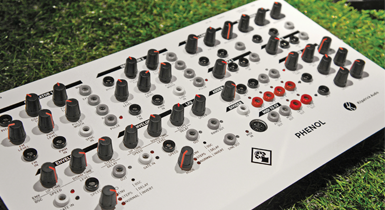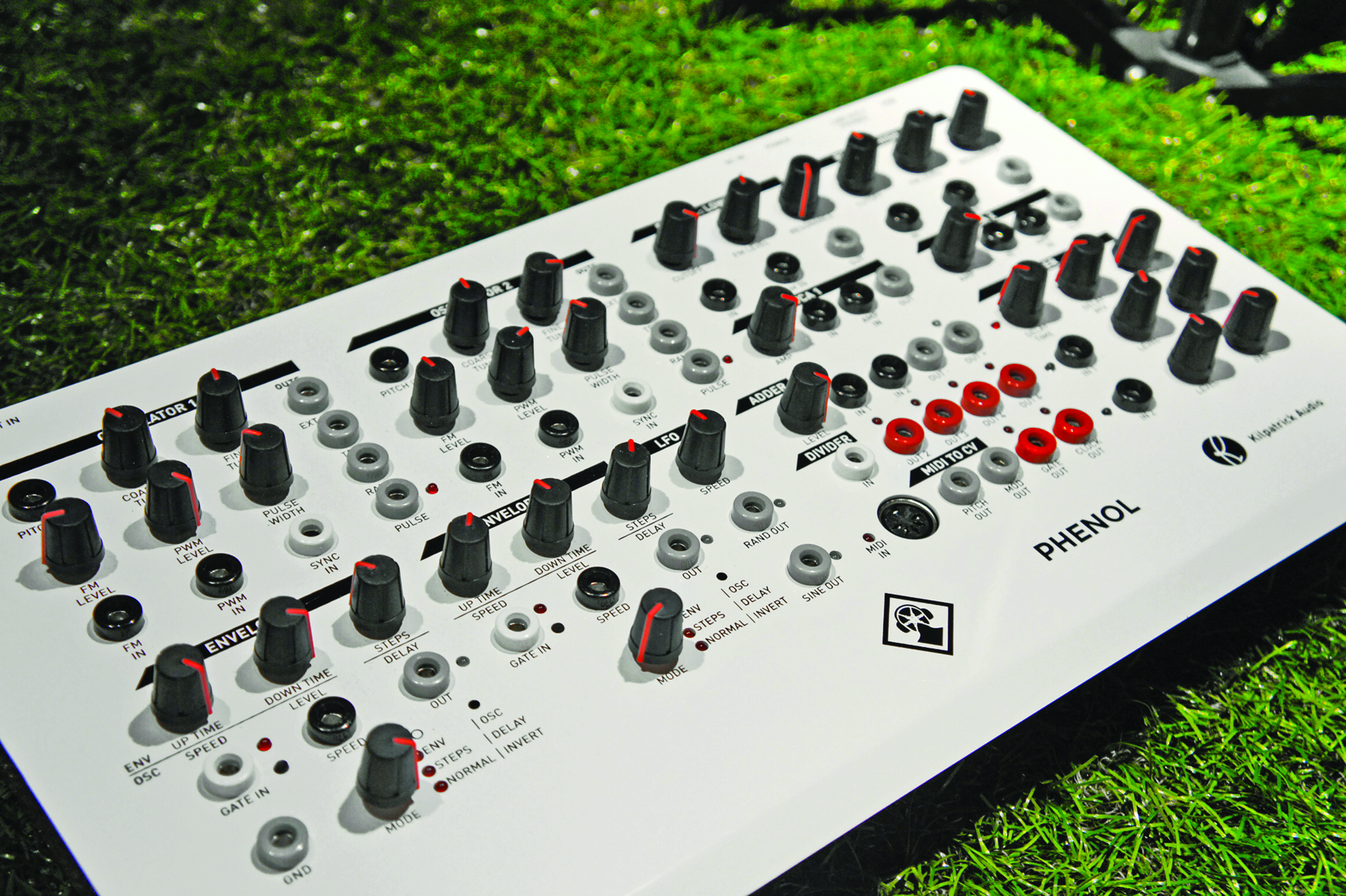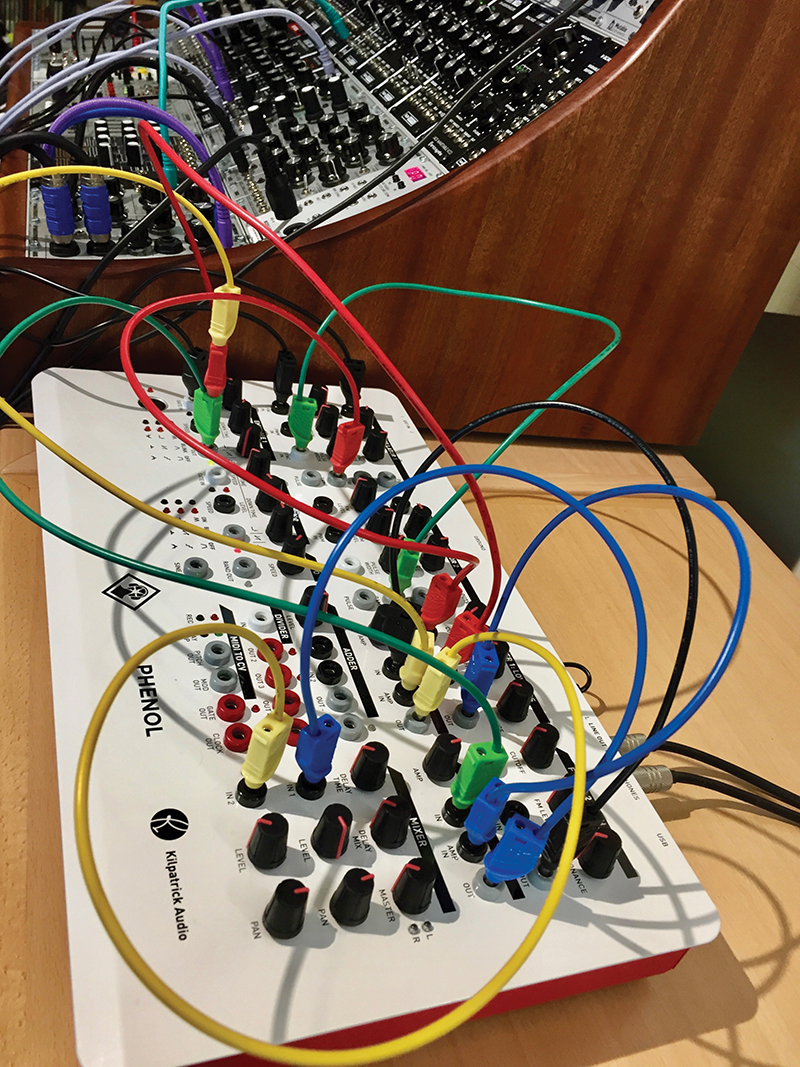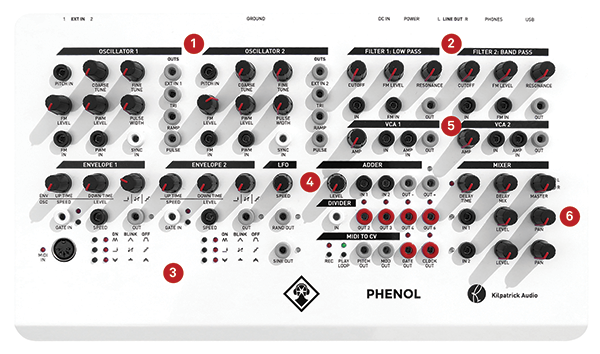Kilpatrick Audio Phenol Review – Stirring Up The Synth World
Originally started via a Kickstarter campaign, the Phenol from Kilpatrick Audio has created quite a stir in the synth world. Dave Gale wires one up, to litmus-test its acidity… Details Kit Phenol Manufacturer Kilpatrick Audio Price $849 (US retail) £777 (street price) Contact andrew@kilpatrickaudio.com Web www.kilpatrickaudio.com Once in a while, a synth comes along that […]

Originally started via a Kickstarter campaign, the Phenol from Kilpatrick Audio has created quite a stir in the synth world. Dave Gale wires one up, to litmus-test its acidity…

Details
Kit Phenol
Manufacturer Kilpatrick Audio
Price $849 (US retail)
£777 (street price)
Contact andrew@kilpatrickaudio.com
Web www.kilpatrickaudio.com
![]()
Once in a while, a synth comes along that creates a bit of a buzz. Canadian company Kilpatrick Audio had already gained some traction with some innovative synth module and effects designs, and thanks to the following this generated, the company began a Kickstarter campaign which raised a more-than-respectable £70k based on the Phenol’s promise.
The voice
The finished product is a patchable synthesiser that boasts a lot of spec. This is not to be confused with some of the semi-patched designs that are currently available, such as the SE Tonestar or Moog Mother-32 – everything needs to be patched, otherwise it will sound very quiet indeed. That means cables, and these take the form of the banana plug design, of which 10 are included.
The advantage with banana plugs is arguably better connectivity, but they are also stackable, meaning that signals can be sent in numerous directions by just patching up another plug on top. The disadvantage is that you can’t patch your Eurorack or similarly mini-jack-based synth straight in, but helpfully, Kilpatrick sells a pack of banana-to-minijack plug cables, which are a must if you have a Eurorack.
Starting at the beginning, the Phenol offers two analogue VCOs, both of which are independently addressed with cabling for pitch CV, alongside other elements, such as FM input, PWM input and Sync In. On the output side, both oscillators offer Saw Ramp, Pulse and Triangle and the ablity to connect an external signal.
Following the signal path through, next, we have a choice of filter, with Filter One being Low-Pass and Filter Two offering Band Pass. These in turn lead to two VCAs, which are identical, and lead to the mixer section, which also offers two inputs. What I like about this design is the large amount of independence of voice: so you could choose to use both oscillators and filters simultaneously, or choose to keep them entirely separate, turning the Phenol into a full two-voice synth.
While we mention the Mixer section, it’s worth stating that the Phenol offers a stereo audio output, and the Mixer section accommodates this by offering both level and pan, as well as a very crunchy delay line, which can be mixed to suit your preference. Stereo in a modular design – that’s very helpful and something of a rarity.
Serging on
And so we come to the modulation side, and turning our attentions to the humble envelope, we find some nice surprises. Kilpatrick has obviously drawn inspiration from various quarters, and nowhere is this more obvious than in the Envelope section. Historically, Serge championed the idea of flexible envelopes that, through control of the attack and decay phases, could exhibit LFO-like behaviour. Serge heavily influenced the Eurorack world with modules such as the legendary Maths from Make Noise, which owes much to the original Serge design, but it’s great to see this in the Phenol, where it can offer many things to the user.
There are two modes of operation, mirrored on both envelopes. The first is either an attack/release- or attack/hold/release-style envelope, with pot controls to indicate the rise and fall times within each, with the second option switching to oscillator mode, where it will rise and fall in a constant cycle, moving into audio range. Mode is selected by pressing one of the buttons below and indicated by a LED which is either dimmed, lit or blinking.
This does take a little time to get used to. However, this is only half the story, as also in this section is the option to use a number of ‘control modes’, allowing the user to introduce steps, a delay to the gate and/or scale quantise into proceedings. This was one of my favourite aspects of the Phenol in general use, as the possible stepping to the envelope phases could induce some excellent effects.
To get a clear idea of what sort of voltages I was hearing in the stepping, I patched the Envelope output to the pitch of one of the oscillators, and here, the applied voltages could
be heard in musical form – with everything from larger intervals up to running semitone-based scales – and all from an envelope, albeit a complex variation of one! Applying the Amount pot above the LED matrix yields differing results with every turn, as the scales become tighter with each turn to the right.
Within the same envelope matrix, it’s also possible to invert the envelope and work with absolute values, meaning that the overall functionality of the envelope is increased further. There are two identical envelopes available, so plenty of modulation possibilities.
As if this weren’t enough, there is a dedicated LFO section right next door, with a basic Sine out, and a random/white-noise output. If you think about it, anything more complicated can be created through the Envelope section, in case you’re concerned about the lack of Pulse/Square output.
If you haven’t got the feeling already, the comprehensive nature of the Phenol is such that there’s plenty of choice for signal routing. Fitting in with that manifesto are the Adder and Divider sections. The Adder section will allow audio or CV signals to be increased by up to 200% which, in the case of audio, can create clipping and overdriving, whereas the Divider will most likely be used for dividing clocks and LFO signals.
Below it, the very tight MIDI to CV/Gate convertor will take an incoming signal from either USB or five-pin MIDI socket, and offer something appropriate for use across the Phenol, or elsewhere in modular. There’s also a looping sequencer inbuilt, making it very easy to build up basic looped sequences for playback regardless of external control, and all of this is clockable via the MIDI signal inputs.
In operation
I started with a basic Saw wave, patched to the Low Pass filter. The filter really does have some lovely character and charm; even without resonance applied, there is a beautiful, almost arp quality and wispiness to the upper frequencies, which make the Phenol immediately endearing. The filter design is entirely unique, and that’s a difficult thing in a world full of endless filter variations: but what you won’t find here is full-on self-oscillation once the resonance is cranked.
There is a slight hint of it, but nothing close to what you might be used to with other filters – but with this comes the fact that the Filter tone and amplitude will not diminish when in a full-on resonated state.
Personally, I like this. In fact, I have to say that I like the filters’ overall colour; they are incredibly pleasing to the ear, and very musical with it. By feeding the signal through the Adder, a nice, subtle sense of overdrive was obtained, again in a very musical way. There is no nasty ‘rip-yer-head-off’ here, just beautiful pleasing tones that can get quite cross when they need to… but overall, you’d be happy to introduce this synth to a set of older parents, and it wouldn’t embarrass itself.
Applying some modulation from the Envelope section swallowed up several hours of my time – and I disappeared down that rabbit hole that you get with some synths. My noodling started with some basic filter control from the Envelope section, extending through to sync tones, all of which benefitted from the extra dimensions offered by the larger control potential of the envelope. The envelope stepping is a real coup here! It’s very unique to an instrument like this and, in tune with the Filter section, offers the user some beautifully nuanced options, coupled with an amazing amount of control.
What had very quickly become apparent in use is how easy it was to patch things in using the stackable banana plugs; which was coupled with an urge to modulate everything in sight. The capacity for tone creation and drone generation is great within the Phenol – so much so, I regrettably found myself running out of patch cables very quickly.
10 are supplied with the Phenol, but given that two could immediately be assigned to MIDI-to-CV/Gate duties, eight cables does not leave very much room for creation, beyond the most basic of patches. Therefore I’d immediately advise you buy an additional set of cables to make up any shortfall.
On the back end of the signal chain, the Mixer section proves its worth by adding in a delay line which, although digital in flavour, is engineered to be gritty and lo-fi. In use, this colour works wonderfully, with the purity of the filters adding further colour to the main output of the Phenol.
Phenol overview
1. VCOs
Two mirrored, analogue VCOs offer complete flexibility to either stack as a single voice, or use completely independently.
2. Filters
The two filters can similarly be used in series or parallel. A beautiful arp-like wispiness in the top end awaits the user.
3. Envelopes
The envelopes are an absolute treasure trove of functionality, with the LED matrix beneath allowing for easy switching of modes.
4. Adder/Divider
Exceptionally useful for audio and CVs, the Adder can offer mild overdriving to the audio, or help increase CV voltage by up to 200%.
5. VCAs
Two nice, clean VCAs are available, should you decide to use two voices rather than opt for a single stacked tone.
6. Mixer
A stereo mixer on a modular? Whatever next? this offers complete control to create a stereo spectrum, and add in some delay for good measure.
Connecting to Euro
One appealing factor of the Phenol could be the option to connect it to any existing equipment you might have, and of course, this might include Eurorack. This is perfectly possible, and will simply require the purchase and addition of Kilpatrick’s own banana-plug-to-mini-jack cables. Once in play, I had my Eurorack firing signals to the Phenol with a fair degree of immediacy, although be aware that length of cable might restrict where you place the Phenol in proximity to your Eurorack.
I personally found the cables to be a little short. Another point to look out for is the ever-recurring phenomena of uni-polar versus bi-polar CV signals. The Phenol is a bi-polar based design, which means not all Eurorack will play nicely.
I must stress this is not unique to the Phenol. It’s a problem that often occurs in Eurorack, with many companies manufacturing conversion solutions to go in either direction, or modules with each in mind. However, with a degree of attenuation and offsetting within my own system, I had plenty of Eurorack modulation coming into play within the Phenol. One place where I did hit a small snag was when I paired the Phenol with the Korg SQ-1 sequencer.
The additional banana-to- mini-jack cables would not trigger and sequence the Phenol, due to the three-pole mini-jack design of the cables, so I had to reach for a MIDI cable to get the SQ-1 to play nicely. On the other hand, though, my Intellijel Metropolis did play very well indeed, further proving the point that this will change from module to module.
One additional feature that has also been thought through is the addition of a ground connection, on the rear of the Phenol, which will helpfully eliminate the issues with noise which can sometimes occur when connecting two different modular devices together from different power points in a setup. Included in the banana-to-mini-jack kit is a cable designed for the task, which just needs plugging into an empty jack point on the connecting Eurorack system.
Do I really need this?
Modular can be daunting as a proposition for anyone looking to enter this mysterious world, so the Phenol offers a simple and effective all-in-one solution that will not only offer plenty sonically, but be capable on so many levels. It’s frankly terrific to see such a well-thought- through product with two of everything that you need, allowing for so much flexibility within a single device. I would defy anyone to get bored of this product, and if you do get bored, you just need to buy some more cables!
Alternatives
Being essentially subtractive in design architecture, there are similarities between the Moog Mother-32 and the SE Tonestar Series, but in terms of oddity, I would say that the Make Noise Co 0-Coast is in the same ballpark, in the sense that it’s a little different from the norm. Although the 0-Coast is not subtractive, due to its lack of filter, it does offer a very interesting option, in a semi-modular design. But, ultimately, with its pure abundance of modulation options, the Phenol offers more.
Conclusion
You get the sense with the Phenol that although this is essentially a subtractive synth voice, everything about it is entirely unique. As you read through the manual, there are continual references to how elements have been engineered to be distinct and part of the Phenol sound, and in operation, this really comes across.
I love synths with character and although at first sight, the user might be forgiven for thinking that the Phenol is a little vanilla, once you start to work with it, you’ll quickly discover that it is anything but.
If you want something akin to a 303, this is not the machine to look at, but if you want a synth with more subtlety, musicality and a well of sounds that is so deep you’ll keep going forever, this should be very high on your list.
I got lost in the Phenol on several occasions, losing all track of time, and that’s always a sign you’ve found something that fits your creative mould. This was largely due to the depth of modulation possibilities, and those glorious envelopes, with their many modes of operation. I’m just off to buy some more banana plugs!
Phenol key features
- Complete synth voice, in a self-contained unit
- Fully patchable design (no hard-wiring)
- Two oscillators, filters, VCAs and envelopes
- MIDI compliant via MIDI and USB sockets
- Analogue voice architecture
- Onboard delay FX
- Stereo output





